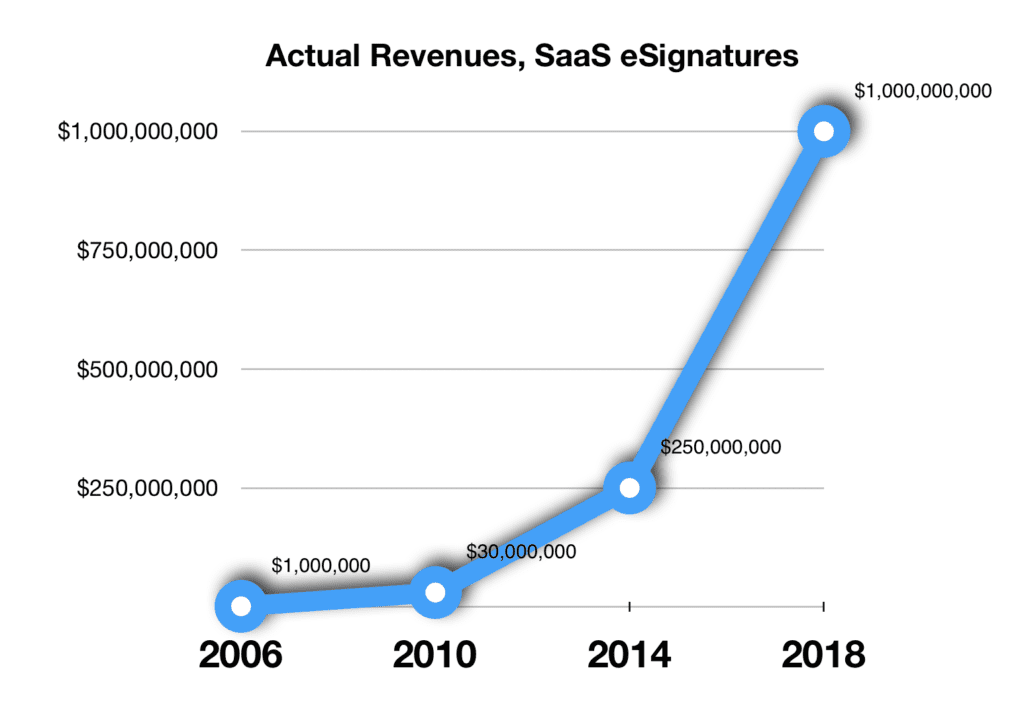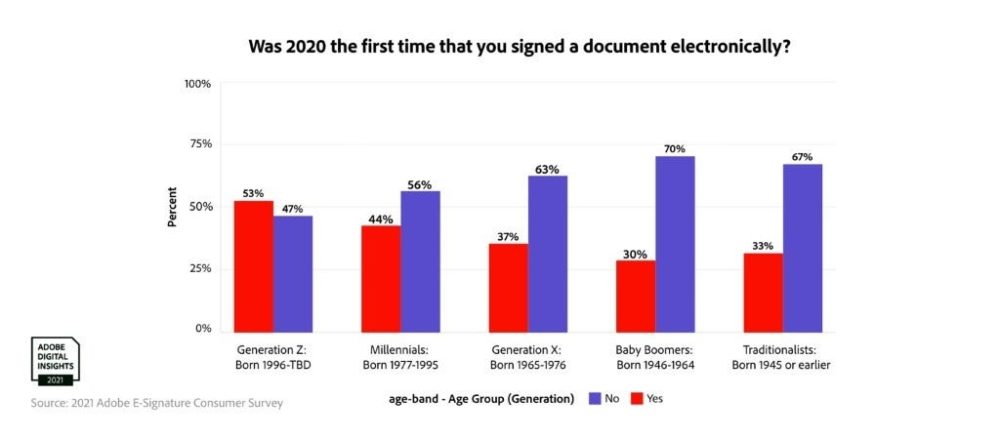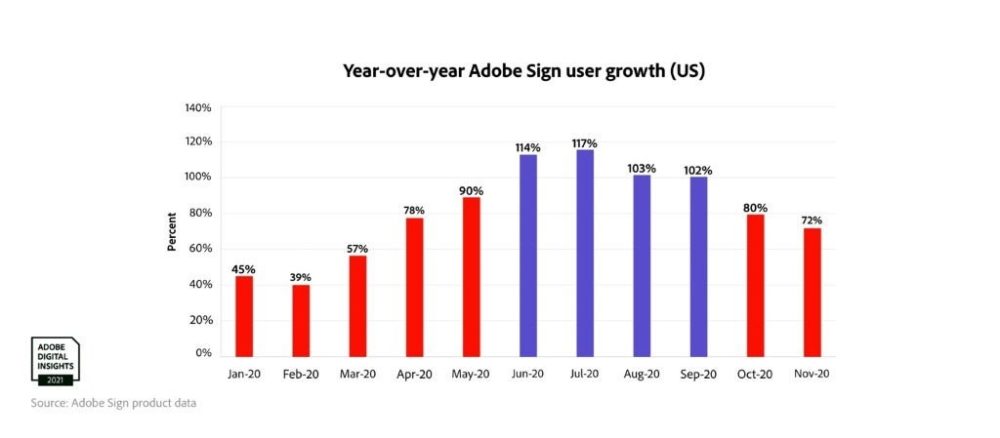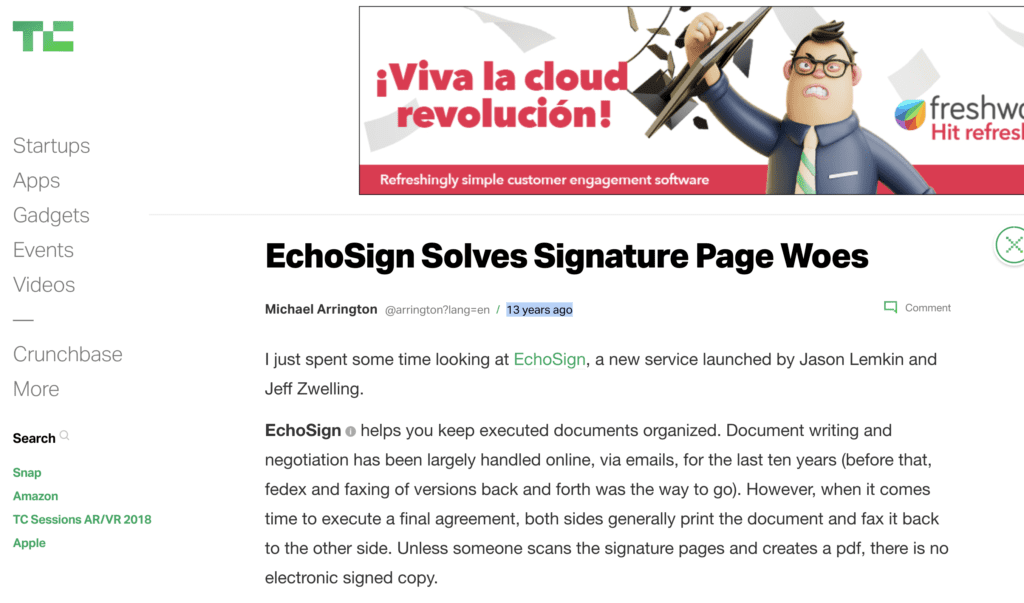Is it better to create a new market, or enter a large existing one? Or even redefine a smaller one, to make it bigger?
All of these can work. But creating a new market might be the vector where it is hardest to conceptualize the actual, true market size of. It’s easy to say if every marketer used your brand new type of product, you’d be doing $100m a year. But will it happen? How big will it really get?
I have a case study for you that I was personally a part of :), the development of the true SaaS eSignature market. It is one I think about a lot — and have a lot of real, hard data on.
We launched Adobe Sign / EchoSign in 2005 as the first true web-based eSignature solution. DocuSign was already a strong brand in a very tiny market, but at the time, half of it was a Windows-based printer driver service. Similar vision, different starting point.
There were other vendors in the market, but they weren’t cloud-based, or not truly SaaS. There are others today that also aren’t truly SaaS, or have an eSignature component (e.g. Conga, RocketLawyer, etc.) but aren’t a pure play.
I’m going to limit this analysis to pure-play SaaS vendors. There aren’t that many of scale so that helps.
In 2006, the actual market — not the TAM, or the theoretical market, or whatever, but the actual market, the money customers actually spent — was just One Million Dollars. That’s it. That was the approximate total actual revenues of the 2 market leaders plus the other pure plays in the market. And our best guess back then of TAM was around $300m-$500m. But actual revenues in 2006 weren’t even 1% of that TAM.
Today, a full 12 years later, the market is one billion in actual, real revenue. Of course, TAM is always greater than current revenues. So let’s assume TAM today is $10 billion (i.e., 10% penetration). And note even the TAM is 20x what we thought it would be in 2006.

Wow, that is a lot of change 🙂 From a $1m actual market — not barely big enough to pay any salaries — to a $1b market today.
What are some of the learnings here from helping create a market:
- First, we didn’t really know until about 6 years in. It’s OK if you can only mostly see it early on. Around 2010, the market got big enough ($30m in actual revenues) that it was organically doubling each year. Only then could you feel it — that it not just could be big, but that it would be big. But even then, the top vendors didn’t know it would be this big. From $30m in 2010 to $1000m in 2018 is a lot of growth. We knew, but we didn’t fully know. Probably not until $100m in total revenues in the category, or Year 6-7 so.
- It compounds. This goes back to the first SaaStr post ever, but it can be hard to feel it. But $30m in 2010 doubles to $60m in 2011, to $120m in 2012, $240m in 2014, $480m in 2015, etc. In fact, the market didn’t even have to really even double each year to reach $1 billion in real, realized revenues in 2018. Doubling each year? Hard, yes. But hardly impossible.
- Vendors change markets, and can make them much larger. Our original comparables were eFax and similar simple document services. But the eSignature leaders quickly realized you could go upmarket from there, and actually radically improve core business processes. That let us grow deal sizes to $100k, then $500k, then $1m, and then beyond. You probably can do the same if you change a category and add dramatically more value to it.
- Top brands endure, and build on themselves. If you have super-high NPS (the top vendors have 50+), net negative dollar churn, and a strong market position — you can scale for decades. Maybe don’t sell at $10m with 50 NPS and 100% YoY growth. Because just think of what that will be in a few years.
- Go long once you get to $10m ARR in a new market. $10m in an old market may be immaterial. But in a new market, that truly is special. If you can find a way to get $10m where there was $0 budget before … of course you can get to $100m.
- In a new category, people will tell you are stupid when you start, and even for quite a while. One of the toughest parts of eSignatures in the early days was that many folks who weren’t customers didn’t get how valuable the products were. A Unicorn CEO looked at me at a dinner and said — and we were already at $8m ARR at this point — “I can’t imagine why anyone would pay for your product”. Yeah, it hurt, even then. And in the earlier days, the doubters were endless. This comes with a new category. Bring a thick skin with you.

Compounding in SaaS is magical. It just may take a decade or so in a new category to really reap the benefits.
Go long. And plan for a rougher start in a new category. But later — you may reap the most benefits of all.




